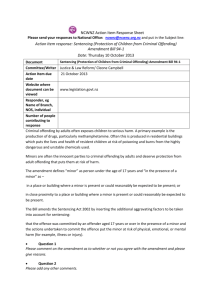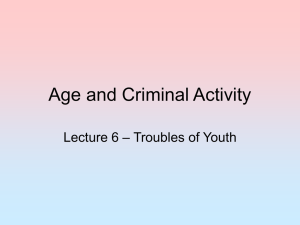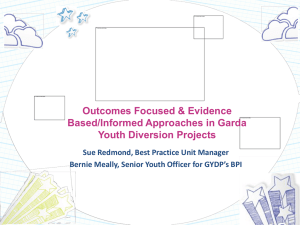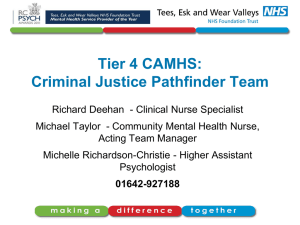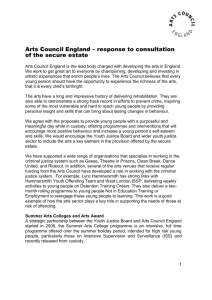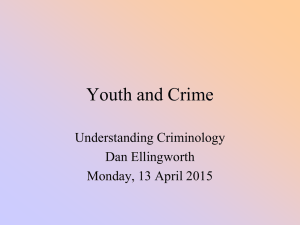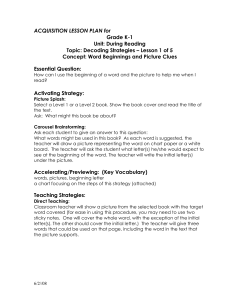Medication Impact on Oral Health, Dr Richard Krebs
advertisement
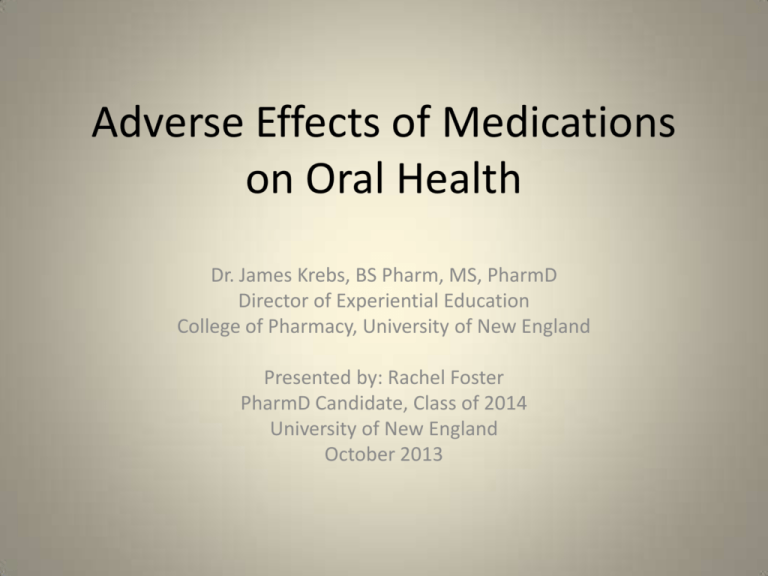
Adverse Effects of Medications on Oral Health Dr. James Krebs, BS Pharm, MS, PharmD Director of Experiential Education College of Pharmacy, University of New England Presented by: Rachel Foster PharmD Candidate, Class of 2014 University of New England October 2013 Objectives • Describe the pathophysiology of various medication-related oral reactions • Recognize the signs and symptoms associated with medication-related oral reactions • Identify the populations associated with various offending agents • Compare the treatment options for medication-related oral reactions Medication-related Oral Reactions • Stomatitis • Burning mouth syndrome • Glossitis • Erythema Multiforme • Oral pigmentation • Tooth discoloration • Black hairy tongue • Oral Candidiasis • Gingival hyperplasia • Alterations in salivation • Alterations in taste • Halitosis • Angioedema Medication-related Stomatitis • Clinical presentation – Aphthous-like ulcers, mucositis, fixed-drug eruption, lichen planus1,2 – Open sores in the mouth • Tongue, gum line, buccal membrane – Patient complaint of soreness or burning http://www.virtualmedicalcentre.com/diseases/oral-mucositis-om/92 0 http://www.virtualmedicalcentre.com/diseases/oral-mucositis-om/920 Medication-related Stomatitis • Offending agents1,2 Medication Indication Patient Population Aspirin •Heart health •Pain reliever • >18 years old • Cardiac patients NSAIDs (i.e. Ibuprofen, naproxen) •Headache •Pain reliever •Fever reducer General population Chemotherapy (i.e. methotrexate, 5FU, doxorubicin, mercaptopurine, bleomycin •Breast cancer •Colon cancer •Lung cancer •Prostate cancer •Oncology patients ACE inhibitors (i.e. captopril, enalapril, lisinopril, etc) •Hypertension •Congestive Heart Failure (CHF) • High blood pressure and cardiac patients Alendronate (Fosamax®) •Osteoporosis •Women >40 years old Antibiotics (i.e. tetracylines) • Infections, various •General population Medication-related Stomatitis • Treatment – Nonpharmacological • • • • • Removal of offending agent Good oral hygiene Ice chips Soft, bland diet Cryotherapy – Indicated for mucositis – Pharmacological3 • Viscous lidocaine – Swish and spit 15mL every 3-4 hours • Benzocaine 10% - 20% – Apply to affected area up to 4 times per day • Systemic analgesia if severe (i.e. mucositis) – COX2 inhibitors (i.e. Celecoxib) – NSAIDs – Gabapentin 100 - 600mg PO TID Burning Mouth Syndrome • Clinical presentation1 – Chief complaint of burning or scalding mouth • Worsening at the end of the day – Associated anxiety – Dry mouth http://curebms.blogspot.com/ Burning Mouth Syndrome • Offending agents1,3 Medication Indication Patient Population ACE inhibitors (i.e. captopriL, enalapril, lisinopril, etc) •Hypertension •Congestive Heart Failure (CHF) • High blood pressure and cardiac patients Antiretrovirals (i.e. lamivudine, zidovudine, emtricitabine, etc) •Human Immunodeficiency Virus (HIV) •HIV/AIDS patients Cephalosporin antibiotics (i.e. cephalexin, cefdinir, etc) •Infections, various •General population Hormone replacement therapy (i.e. estradiol) •Menopause • Women age 40-60 Burning Mouth Syndrome • Treatment – Nonpharmacological • • • • • Removal of offending agent Good oral hygiene Avoidance of spicy, acidic foods Ice chips Brush with baking soda and water – Pharmacological1 • Pilocarpine 5mg TID, MAX dose 30mg/day • Alpha-lipoic acid 200-600mg daily • Clonazepam 0.5mg BID, target dose of 1mg daily Glossitis • Clinical presentation – “Strawberry tongue” – Absent papillae – Swollen tongue (or patches of swollen tongue) – Patient complaints of • Soreness • Difficulty swallowing, chewing, speaking Glossitis • Offending agents3 Medication Indication Patient Population Atorvastatin (Lipitor®) High cholesterol • >30 years old •Overweight •Cardiac patients Carbamazepine (Tegretol®) •Bipolar disorder •Epilepsy • General population •Psychiatric patients Doxepin •Alcoholism •Anxiety •Depression •Insomnia •Pruritis Various Gold compounds Rheumatoid arthritis Various Xerostomizing medications -- -- Glossitis • Treatment – Nonpharmacological • Removal of offending agent • Good oral hygiene – Pharmacological2 • Lidocaine mouth rinse – Swish and spit 15mL every 3-4 hours • Diphenhydramine (Benadryl®) mouth rinse – Swish and spit 15mL 2-3 times per day • Dexamethasone (Decadron®)mouth rinse – Swish and spit 15mL 1-2 times per day Erythema Multiforme • Clinical presentation1,2 – Mucocutaneous inflammation – Symmetrical edematous, bullous lesions – Ranges from self-limited to life-threatening Erythema Multiforme • Offending agents1 Medication Indication Patient Population Antibiotics (Penicillin, amoxacillin, cefdinir, cephalexin, etc) Infections, various General population Allopurinol Gout •Men > Women (3:1) • > 40 years old Carbamazepine (Tegretol®) •Bipolar disorder •Epilepsy • General population •Psychiatric patients Bactrim® (Sulfamethoxazole + Trimethoprim) •Infection, various •Various NSAIDs (i.e. Diclofenac, •Headache ibuprofen, •Pain reliever indomethacin) •Fever reducer General population Phenytoin Various Seizure disorder Erythema Multiforme • Treatment – Nonpharmacological • Removal of offending agent • Debridement (if lesions are severe) • Avoidance of hot, spicy, acidic foods – Pharmacological • Lidocaine mouth rinse – Swish and spit 15mL every 3-4 hours • Diphenhydramine (Benadryl®) mouth rinse – Swish and spit 15mL 2-3 times per day • Dexamethasone (Decadron®)mouth rinse – Swish and spit 15mL 1-2 times per day • Chlorhexidine mouth rinse – Swish and spit 15mL 2-4 times per day • Systemic corticosteroids – Dexamethasone taper – Prednisone taper • Antibiotics – Amoxacillin 500mg Q12H Oral Pigmentation • Clinical presentation – Often asymptomatic – Bluish-gray to yellowish-brown discoloration of the buccal mucosa, tongue, hard palate, gingiva http://heritageoakdental.com/start/?page_id=441 http://heritageoakdental.com/start/?page_id=441 Oral Pigmentation • Offending agents1-3 Medication Indication Patient Population Doxorubicin •Breast cancer •Colon cancer •Lung cancer •Prostate cancer •Oncology patients Minocycline •Infection, various •Acne treatment • General population • Adolescents Phenytoin Seizure disorder Various Quinines (i.e. chloroquinine, mefloquinine, etc) Malaria Travelers Phenothiazines (i.e. fluphenazine, chlorpromazine, perphenazine, etc) •Schizophrenia •Nausea/Vomiting • Psychiatric patients • Chemotherapy patients • Other Zidovudine HIV •HIV patients Amiodarone •Arrhythmias •Heart failure •Cardiac patients Illicit drugs (i.e. crack, cocaine, heroin) -- • Drug abusers Oral Pigmentation • Treatment – Rule out oral cancers – Nonpharmacological • • • • Removal of offending agent Laser removal of pigmentation Cryosurgery Abrasion technique Tooth Discoloration • Extrinsic and/or intrinsic discoloration of the tooth – Yellow – Brown – Blue-gray http://www.oralanswers.com/2010/09/tetracycline-tooth-staining-cause-treatment-prevention/ Tooth Discoloration • Offending agents Medication Indication Patient Population Tetracyclines (i. e. minocycline, tetracycline, doxycycline etc) •Acne •Infection, general • Adolescents •General population Ciprofloxacin •Infection General population Tooth Discoloration • Treatment – Removal of offending agent – External dental cleaning – Bleaching Black Hairy Tongue • Clinical presentation – Black, hair-like appearance on back of tongue http://www.mayoclinic.com/health/medical/IM03891 Black Hairy Tongue • Offending agents1-3 Medication Indication Patient Population Broad spectrum antibiotics (i.e. cephalosporins, sulfonamides, tetracyclines) •Infection •General Tricyclic antidepressants (amitriptyline, clomipramine, nortriptyline) • Depression •Neuralgia • General population • Patients with chronic pain Griseofulvin • Fungal (tinea) infection • children > adults Black Hairy Tongue • Treatment – Nonpharmacological • Patient education – Good oral hygiene – Smoking cessation • Removal of offending agent – Pharmacological3 • Nystatin mouth rinse – 4-6mL held in mouth one minute before swallowing – Continue use for 2 days after symptoms are gone • Fluconazole – 100-200mg daily x7-14 days • 50% Trichloroacetic acid Oral Candidiasis • Clinical Presentation – Whitish, velvety sores in the mouth and on the tongue http://www.entusa.com/oral_photos.htm Oral Candidiasis • Offending agents1 Medication Indication Patient Population Antiretrovirals (i.e. lamivudine, zidovudine, emtricitabine, etc) •Human Immunodeficienc y Virus (HIV) •HIV/AIDS patients Antibiotics (Penicillin, Infections, various General population amoxacillin, cefdinir, cephalexin, etc) Corticosteroids (dexamethasone, fluticasone, prednisone) •Asthma •Inflammation •Various Chemotherapy agents •Breast cancer •Colon cancer •Lung cancer •Prostate cancer •Oncology patients Oral Candidiasis • Treatment – Nonpharmacological • Removal of offending agent • Good oral hygiene • Probiotics (yogurt) – Pharmacological • 3% hydrogen peroxide rinses – Swish and spit 15mL 3-4 times per day • Nystatin mouth rinse – 4-6mL held in mouth one minute before swallowing – Continue use for 2 days after symptoms are gone • Fluconazole – 100-200mg daily x7-14 days Gingival Hyperplasia • Clinical presentation – Overgrowth of gums – Red, swollen gums – Displaced teeth and plaque depositions predispose patients to gingival hyperplasia http://www.medicinenet.com/image-collection/gingival_hyperplasia_from_phenytoin_picture/picture.htm Gingival Hyperplasia • Offending agents1 Medication Indication Patient population Anticonvulsants (phenytoin, valproate, topirimate, phenobarbital) •Seizures •Bipolar disorder •Epileptics •Psychiatric patients Cyclosporin •Heart transplant •Liver transplant •Kidney transplant • Transplant patients •Surgery patients Calcium channel blockers (nifedipine, amlodipine, diltiazem, nicardipine, verapamil) •Hypertension •Angina •Post MI •Cardiac patients Gingival Hyperplasia • Treatment – Nonpharmacologic • Removal of offending agent • Good oral hygiene – Plaque control – Pharmacologic • Cyclosporin-induced gingival hyperplasia – Azithromycin 250mg BID on day 1, then 250mg daily x6 days Alterations in Salivation • Clinical presentation – Patient complaint (dry mouth, painful salivation) – Secondary complications • Dental caries, infection, ulcers, dysphagia http://www.webmd.com/oral-health/salivary-glands Alterations in Salivation • Offending agents1-3 – Xerostomia Medication Class Indication Patient population Antihistamines (Benadryl®, Claritin®, Allegra®, etc) •Allergies •Insomnia •General population Antidepressants (SSRIs, TCAs, MAOIs) •Depression •Neuralgia •Insomnia •Various Triptans (Imitrex®, conivaptan, •Migraine zolmitriptan, naratriptan) headaches Antihypertensives (Betablockers, calcium channel blockers, alpha-agonists) •Hypertension •Heart disease • >18 years old • Female > male Cardiac patients Alterations in Salivation • Offending agents1 – Sialorrhea Medication Indication Patient Population Clozapine (Clozaril®) Schizoprenia Psychiatric patients Digoxin (Digitek®) •Atrial fibrillation •Heart failure Cardiac patients Pilocarpine (Salagen®) •Glaucoma •Xerostomia •Diabetic patients •Cancer patients Risperidone (Risperdal®) •Autistm •Bipolar disorder •Schizoprenia •Autistic patients •Psychiatric patients Alterations in Salivation • Treatment – Nonpharmacological • Removal of offending agent • Good oral hygiene – Pharmacological • Xerostomia – Pilocarpine 5mg TID, MAX dose 30mg/day – Bethanechol • Sialorrhea – Atropine drops 1-2 drops as needed – Clonidine patch 0.1mg/day patch » Change every 7 days Alterations in Taste • Clinical presentation – Patient complaint • Loss of taste • “Decreased salty taste” • Metallic taste http://dribrook.blogspot.com/p/radiation-side-effects.html Alterations in Taste • Offending agents1,2 Medication Taste Alteration Indication Patient population Sulfhydryl compounds (Sulfonamides, sulfonylureas, etc) Decreased taste • Infection •Diabetes Mellitus •General • Diabetics Penicillamine Decreased to total loss of taste •Cystinurea •Rheumatoid arthritis (RA) •Patients with kidney stones • RA: women > men ACE inhibitors (captopril, enalapril) Decreased “salty” taste •Hypertension Cardiac patients Griseofulvin Decreased to total loss of taste • Fungal (tinea) infection • children>adults Proton pump inhibitors (Protonix®, Prevacid®, Nexium®) Altered or decreased taste •Heart burn •Reflux disease • >18 years old •Pregnancy Corticosteroids (dexamethasone, fluticasone, prednisone) Decreased taste •Asthma •Inflammation •Various Chemotherapy agents Metallic taste > decreased taste •Breast cancer •Colon cancer •Lung cancer •Oncology patients Alterations in Taste • Treatment – Nonpharmacological • Removal of offending agent • Good oral hygiene • Increased water intake with medications – Pharmacological treatment • Radiation and chemotherapy-induced alterations: – Zinc supplementation Halitosis • Clinical presentation – Patient complaint of constant foul taste in mouth – Secondary causes • • • • Dry mouth Infection Excessive alcohol consumption Respiratory infection Halitosis • Offending agents1 Medication Indication Patient population Chemotherapy agents •Breast cancer •Colon cancer •Lung cancer •Prostate cancer •Oncology patients Disulfiram (Antabuse®) •Alcoholism •Alcoholics Nitrates •Angina •Heart disease Cardiac patients Xerostomizing medications -- -- Halitosis • Treatment – Good oral hygiene – Tobacco cessation – Alcohol cessation – Keep a food log Angioedema • Clinical presentation – Sudden onset – Swelling, redness • Lips • Throat (pharynx, larynx) • Eyelids Angioedema • Offending agents1,3 Medication Indication Patient Population NSAIDs (i.e. Ibuprofen, naproxen) •Headache •Pain reliever •Fever reducer General population ACE inhibitors (i.e. captopril, enalapril, lisinopril, etc) •Hypertension •Congestive Heart Failure (CHF) • High blood pressure and cardiac patients Sulfhydryl compounds (Sulfonamides, sulfonylureas, etc) Decreased taste • Infection •Diabetes Mellitus Angioedema • Treatment – Refer patient to Emergency Department – Removal of offending agent – Antihistamines • Benadryl® Summary • Most medication-related oral reactions occur within one to two weeks of initiation of therapy1 • The most frequent medication-related oral reactions are xerostomia, dysgeusia and stomatitis1 • The most common offending agents are chemotherapy agents, antibiotics, antihistamines and psychotropic medications • First line treatment for most medication-related oral reactions is good oral hygiene Questions More questions? • Rachel Foster – Email: rfoster2@une.edu • Dr. Jim Krebs – Email: jkrebs@une.edu References 1. Abdollahi, Mohammad, and Roja Rahimi. "Current Opinion on DrugInduced Oral Reactions: A Comprehensive Overview." Journal of Contemporary Dental Practice 9.3 (2008): 2-29. Print. 2. Tack, Alan, and Roy Rogers. "Oral Drug Reactions." Dermatologic Therapy 15 (2002): 236-50. Print. 3. Micromedex. Micromedex, n.d. Web. 22 Aug. 2013. <http:/www.micromedexsolutions.com.une.idm.oclc.org/microm edex2/librarian>.
